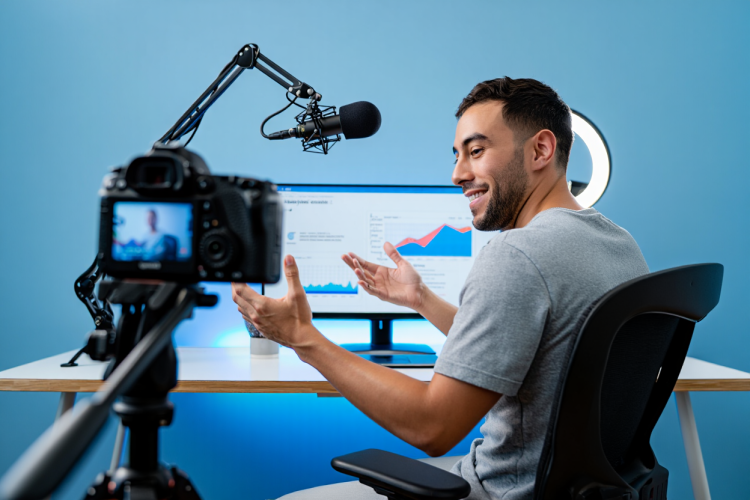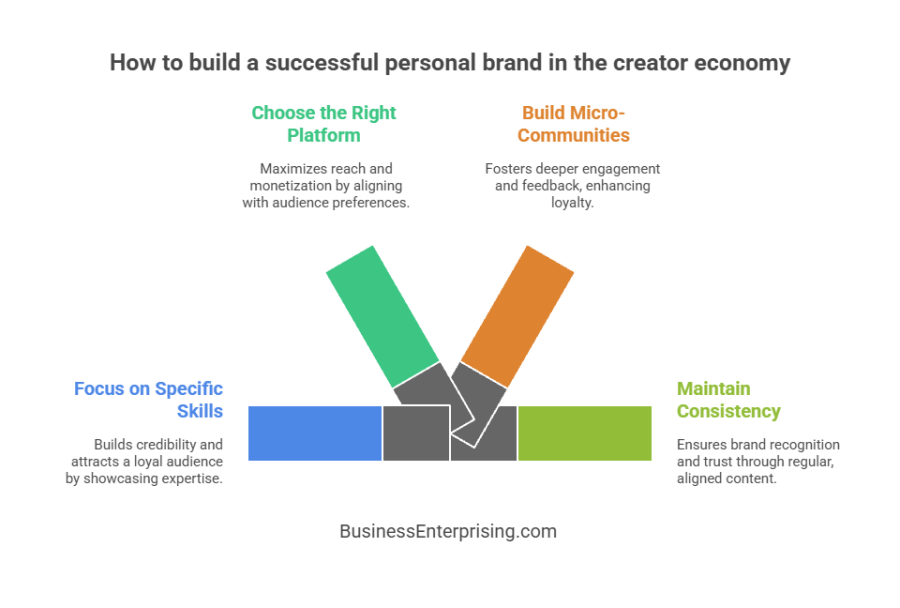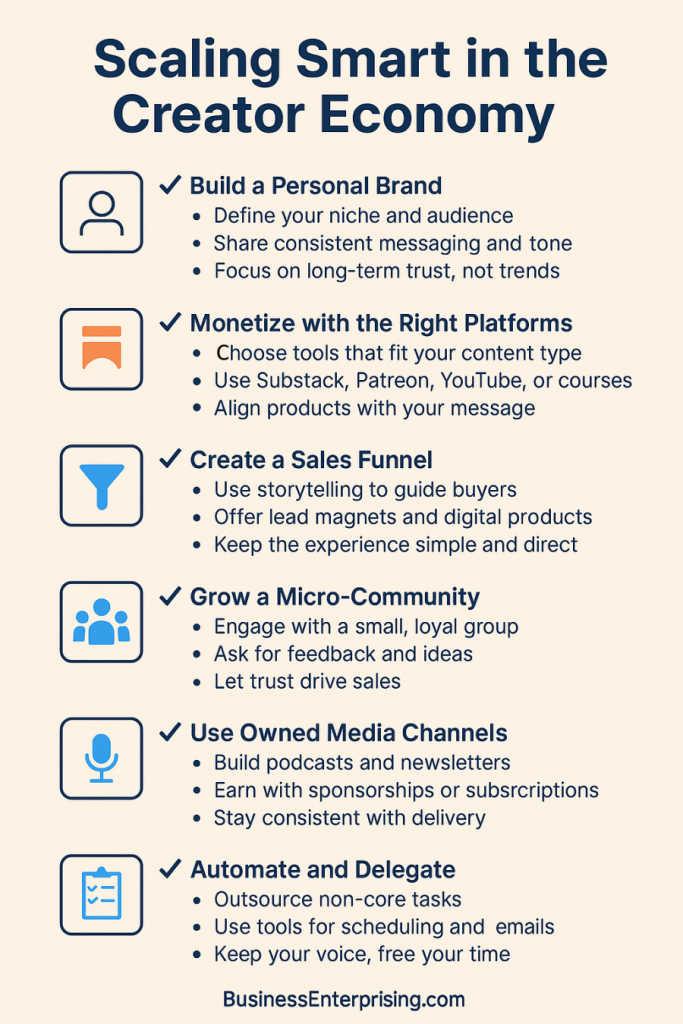
Additionally, the tools to build your brand are easier to access. You can start with a phone, a laptop, and your ideas. However, growing a personal brand takes more than content. You need clear goals, strong systems, and consistent communication. These things shape how others see your work over time.
Therefore, creators who treat their work like a business often grow faster. They focus on specific skills, solve problems, and serve people who trust them. That trust turns into opportunities, income, and long-term support. You do not need a massive following to see results. You need the right structure and message.
Building a brand is not only about promotion. It’s also about alignment. What you say must match what you sell and how you act. When those pieces stay consistent, people respond. Additionally, your process becomes easier to manage. That allows you to scale without burnout or confusion.
This article explores how creators build systems, grow income, and protect their identity. Each step matters. Taken together, they form a model that works.
The Rise of the Solopreneur: Building a Personal Brand from Scratch
Solopreneurs are changing how people think about business. You no longer need a large company to create influence or build trust. Many individuals now operate as full brands, offering products, content, or services directly to their audience. You shape how people see you based on your skills, voice, and consistency.
Many successful creators choose a specific topic or field they understand well. They focus on showing real knowledge instead of trying to please everyone. This approach builds credibility. When you stay focused, people know what to expect from you and return for more. That kind of loyalty takes time but pays off long term.
Personal branding works best when it feels natural. Audiences connect with people who are consistent and relatable. Your values and tone must match across platforms. People pick up on inconsistencies quickly, especially on social media. Therefore, it helps to keep things simple and honest. You do not need a big team to do that well.
Additionally, sharing your process and thinking can help others trust you. It also keeps you top of mind. This kind of transparency builds stronger relationships over time. When people follow your work and see steady progress, they start to associate your name with your niche.
The Creator Economy and Personal Branding both rely on how clearly you communicate what you do. Building a brand from scratch takes regular effort. However, if you keep showing up and providing value, your brand will grow along with your reputation.
Monetization Platforms: Substack, Patreon, YouTube, and Beyond
If you create content regularly, you’ve likely explored ways to get paid for it. Several platforms now support direct monetization. Substack, Patreon, YouTube, and online course sites give you options to earn without needing a middleman. Each one works a little differently and attracts different kinds of audiences.
Substack helps writers earn by offering paid email subscriptions. You own your list and control what gets sent. Therefore, this model supports long-term growth with direct relationships. Patreon lets fans subscribe to your content through tiered memberships. It rewards steady content and makes your audience part of your ongoing work.
YouTube uses ad revenue and offers memberships and sponsorships. However, it owns the algorithm, so you have less control over how your content is seen. If your videos don’t get picked up by the platform, you may not earn much. That makes consistency and format important. Online courses offer another path. You can sell through platforms that handle payments and delivery. This works well if you teach a skill or provide knowledge people want.
Additionally, each platform scales differently. Courses and newsletters grow through trust and direct outreach. Video content often spreads through algorithms and search. Therefore, your strategy should match your content style and how much control you want. The Creator Economy and Personal Branding depend on choosing the right channel. When you match your platform to your goals, you gain more than money. You also gain stability and freedom.
The Power of Micro-Communities: Community-Led Growth Strategies
Smaller communities often create stronger connections. Many creators now focus on building micro-tribes rather than chasing large, passive audiences. These groups form around shared values, interests, or goals. You can create deeper engagement by speaking directly to people who care about what you do.
Additionally, small groups give better feedback. Your audience will tell you what they like, what they need, and what they will pay for. This kind of input helps guide your content and product decisions. Therefore, you can create offerings that match real demand, not guesses. You save time and increase revenue by serving people who already trust you.
When people feel heard, they stick around. They also refer others and buy more often. That kind of loyalty can support long-term income. Micro-communities often become the testing ground for new ideas. You can launch a product, course, or membership with direct support from the group.
Creators also benefit from informal leadership roles within these circles. You do not need a large platform to be seen as an expert. However, you do need consistency and interaction. That means showing up, replying to comments, and recognizing your most active supporters.
The Creator Economy and Personal Branding both depend on real connection. A small, trusted group often brings more value than a large, quiet following. If you take care of your micro-community, it will take care of your brand.
Podcasting and Newsletters: Sustainable Media Assets in the Creator Stack
Podcasts and newsletters give you control over your message. These formats are owned media, which means you are not dependent on algorithms. You can send your content directly to listeners and readers without outside filters. That helps you keep attention and build trust over time.
Additionally, both channels offer ways to earn steady income. Sponsorships, affiliate links, and paid subscriptions all support recurring revenue. You can keep your format simple or expand into premium content. Many creators also use these channels to drive sales for their own products or services. That allows you to earn without relying on platform payouts.
Podcasts give your audience a direct line to your voice. They also build a habit of tuning in regularly. Therefore, you stay top of mind. Newsletters offer a similar benefit. When readers hear from you each week, they begin to see you as a reliable source. That consistency helps grow your authority and personal brand.
You do not need a massive following to succeed with either format. What matters more is quality, timing, and relevance. When your audience sees value in what you share, they stay engaged and support your work. That creates a strong base for growth. The Creator Economy and Personal Branding both reward creators who build trust over time. Podcasts and newsletters help you do that while staying independent. If you commit to the process, these tools will serve you well.
From Attention to Transaction: The Creator Sales Funnel
Turning attention into income starts with clarity. People follow creators because they find value, connection, or consistency. However, attention alone does not create revenue. You need a system that guides your audience toward action. That system begins with your story and ends with a clear offer.
Your personal story creates trust. When you share why you do what you do, people feel more connected. Therefore, you should build content around your message. That message becomes the base for your digital products, services, or subscriptions. Additionally, a clear narrative helps followers understand what they can expect from you.
Lead magnets help move people from passive followers to active subscribers. These small offers might include templates, downloads, or previews. The goal is not to sell right away. Instead, it creates a step between content and purchase. Once someone joins your list, you can offer more value over time. That builds trust and prepares them to buy.
Digital products work best when they align with your content and audience needs. Courses, guides, and paid communities can all support your brand. However, they must feel like a natural extension of what you already share. That alignment keeps your message strong and your audience engaged.
The Creator Economy and Personal Branding both reward clarity and intention. If you take your audience from attention to transaction with care, sales will follow.
Scaling Without Selling Out: Growth, Delegation, and Digital Infrastructure
Growth brings new pressure. As your audience expands, so do the demands on your time and energy. Many creators experience burnout from trying to manage everything themselves. However, scaling doesn’t mean giving up control. It means building systems that support your work without draining you.
You can start by reviewing what takes up the most time. Repeating tasks like editing, emails, and scheduling can often be automated. Tools can handle these functions in the background. Additionally, you can outsource tasks that require skill but not your voice. This may include design, bookkeeping, or customer support. Clear instructions and systems help others support your brand without changing your message.
Staying true to your voice is non-negotiable. Therefore, you must define your tone, values, and visual style. These guidelines help others represent your brand accurately. When you lead with clarity, your team or tools can work behind the scenes without confusion.
Digital infrastructure also supports growth. You need a place for content, payments, and communication to run smoothly. A website, email system, and product platform should work together. That way, your audience experiences consistency from start to finish. This consistency strengthens your reputation.
The Creator Economy and Personal Branding support those who can grow without losing focus. When you scale with intention, you keep your time and your identity.
Conclusion
Creators now have more control than ever. You can build your brand, choose your platform, and grow your income on your terms. However, doing that well requires planning, focus, and consistency. Success depends less on reach and more on trust, systems, and alignment with your message.
Additionally, you must treat your work like a business. That means understanding where your time goes and what drives results. When you focus on the right efforts, your output becomes more efficient. Therefore, your audience sees steady value, and your brand stays strong.
Each tool in your content stack plays a role. Whether it’s a podcast, course, or email list, these tools work together. You don’t need all of them at once. However, you do need a plan to use the ones that fit. Your personal story should connect each part to your broader goals.
The Creator Economy and Personal Branding are built on small, repeated actions. Over time, these choices define how people see your work. If you stay consistent and build systems to support your efforts, growth becomes manageable and sustainable. Additionally, you avoid burnout and keep control of your brand. Keep it simple. Focus on value. Let your work speak clearly. That’s how you turn creativity into a stable business.



